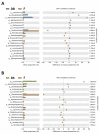Metagenetic Analysis for Microbial Characterization of Focaccia Doughs Obtained by Using Two Different Starters: Traditional Baker's Yeast and a Selected Leuconostoc citreum Strain
- PMID: 34070312
- PMCID: PMC8225195
- DOI: 10.3390/foods10061189
Metagenetic Analysis for Microbial Characterization of Focaccia Doughs Obtained by Using Two Different Starters: Traditional Baker's Yeast and a Selected Leuconostoc citreum Strain
Abstract
Lactic acid bacteria (LAB) decisively influence the technological, nutritional, organoleptic and preservation properties of bakery products. Therefore, their use has long been considered an excellent strategy to improve the characteristics of those goods. The aim of this study was the evaluation of microbial diversity in different doughs used for the production of a typical Apulian flatbread, named focaccia. Leavening of the analyzed doughs was obtained with baker's yeast or by applying an innovative "yeast-free" protocol based on a liquid sourdough obtained by using Leuconostoc citreum strain C2.27 as a starter. The microbial populations of the doughs were studied by both a culture-dependent approach and metagenetic analyses. The flours used for dough preparation were also subjected to the same analyses. The metagenetic analyses were performed by sequencing the V5-V6 hypervariable regions of the 16S rRNA gene and the V9 hypervariable region of the 18S rRNA gene. The results indicate that these hypervariable regions were suitable for studying the microbiota of doughs, highlighting a significant difference between the microbial community of focaccia dough with baker's yeast and that of the dough inoculated with the bacterial starter. In particular, the dough made with baker's yeast contained a microbiota with a high abundance of Proteobacteria (82% of the bacterial population), known to be negatively correlated with the biochemical properties of the doughs, while the Proteobacteria in dough produced with the L. citreum starter were about 43.5% lower than those in flour and dough prepared using baker's yeast. Moreover, the results show that the L. citreum C2.27 starter was able to dominate the microbial environment and also reveal the absence of the genus Saccharomyces in the dough used for the production of the "yeast-free" focaccia. This result is particularly important because it highlights the suitability of the starter strain for obtaining an innovative "yeast-free" product.
Keywords: baker’s yeast; lactic acid bacteria; liquid sourdough; metagenetic analysis; microbiota; yeast-free dough.
Conflict of interest statement
The authors declare no conflict of interest.
Figures








Similar articles
-
Use of a Selected Leuconostoc Citreum Strain as a Starter for Making a "Yeast-Free" Bread.Foods. 2019 Feb 13;8(2):70. doi: 10.3390/foods8020070. Foods. 2019. PMID: 30781845 Free PMC article.
-
Yeast Biodiversity in Fermented Doughs and Raw Cereal Matrices and the Study of Technological Traits of Selected Strains Isolated in Spain.Microorganisms. 2020 Dec 26;9(1):47. doi: 10.3390/microorganisms9010047. Microorganisms. 2020. PMID: 33375367 Free PMC article.
-
Application of selected lactic acid bacteria isolates for bread production without baker's yeast.Food Sci Biotechnol. 2024 Apr 27;33(14):3279-3290. doi: 10.1007/s10068-024-01571-7. eCollection 2024 Nov. Food Sci Biotechnol. 2024. PMID: 39328226 Free PMC article.
-
Inventions on baker's yeast strains and specialty ingredients.Recent Pat Food Nutr Agric. 2009 Jun;1(2):104-32. doi: 10.2174/2212798410901020104. Recent Pat Food Nutr Agric. 2009. PMID: 20653532 Review.
-
Sourdough-Based Biotechnologies for the Production of Gluten-Free Foods.Foods. 2016 Sep 20;5(3):65. doi: 10.3390/foods5030065. Foods. 2016. PMID: 28231160 Free PMC article. Review.
Cited by
-
Advances in the Use of Beneficial Microorganisms to Improve Nutritional and Functional Properties of Fermented Foods.Foods. 2024 Jan 2;13(1):155. doi: 10.3390/foods13010155. Foods. 2024. PMID: 38201180 Free PMC article.
-
Microbial Ecology and Nutritional Features in Liquid Sourdough Containing Hemp Flour Fermented by Lactic Acid Bacterial Strains.Foods. 2025 Feb 1;14(3):469. doi: 10.3390/foods14030469. Foods. 2025. PMID: 39942061 Free PMC article.
References
-
- Catzeddu P. Sourdough Breads. In: Preedy V.R., Watson R.R., Patel V.B., editors. Flour and Breads and Their Fortification in Health and Disease Prevention. Academic Press; Cambridge, MA, USA: Elsevier; London, UK: Burlington, VT, USA: San Diego, CA, USA: 2011. pp. 37–46. - DOI
-
- Suo B., Nie W., Wang Y., Ma J., Xing X., Huang Z., Xu C., Li Z., Ai Z. Microbial diversity of fermented dough and volatile compounds in steamed bread prepared with traditional Chinese starters. LWT Food Sci. Technol. 2020;126:109350. doi: 10.1016/j.lwt.2020.109350. - DOI
-
- Decreto Ministeriale 7 Febbraio 2019. Aggiornamento Dell’elenco Nazionale Dei Prodotti Agroalimentari Tradizionali Ai Sensi Dell’articolo 12, Comma 1, Della Legge 12 Dicembre 2016, N. 238. Gazzetta Ufficiale N. 60 Del 12 Marzo 2019–Supplemento Ordinario N. 9. [(accessed on 3 May 2021)]; Available online: http://www.gazzettaufficiale.it/eli/gu/2019/03/12/60/so/9/sg/pdf.
-
- Pasqualone A., Delcuratolo D., Gomes T. Focaccia Italian flat fatty bread. In: Preedy V.R., Watson R.R., Patel V.B., editors. Flour and Breads and Their Fortification in Health and Disease Prevention. Academic Press; Cambridge, MA, USA: Elsevier; London, UK: Burlington, VT, USA: San Diego, CA, USA: 2011. pp. 47–58. - DOI
Grants and funding
LinkOut - more resources
Full Text Sources
Molecular Biology Databases
Miscellaneous

